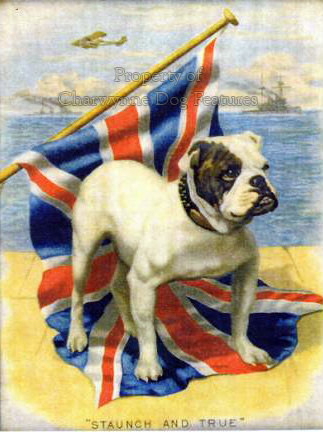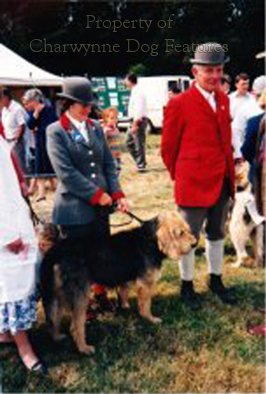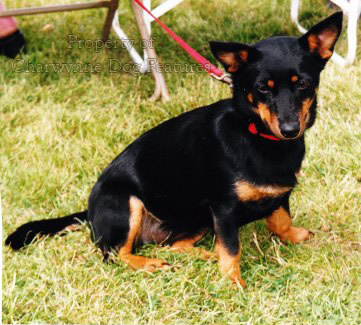818 SAVING THE ENGLISH DOG
SAVING THE ENGLISH DOG
by David Hancock
 National Pride
National Pride
There is an enormous difference between national pride and xenophobia. As an island people we have for centuries traded our outgoing goods and those of others coming in - including dogs. Foreign breeds of dog grace our streets and our show rings. They must always be welcomed. But we have valuable English breeds of dog that must not be allowed to vanish through the idle pursuit of fashion and the sheer fickleness of both owners and dog-dealers. Such an argument is hardly new. The editorial in The Kennel Gazette of September 1893 was entitled "Alien Dogs" and was headed by Smart's lines of 1722:
"An English dog can't take an airing
But foreign scoundrels must be staring.
I'd have your French dogs and your Spanish,
And all your Dutch and all your Danish,
By which our species is confounded,
Be hanged, be poisoned and be drowned;
No mercy on the race suspected,
Greyhounds from Italy excepted."
This writer went on to state, perhaps illogically: "It may, therefore, be inferred that I cry out against the introduction of foreign dogs, it will rather please me to see England become the world's market for the canine race...Where would our shows be without the foreign element; we have not English breeds enough to fill the benches of a village exhibition." This somewhat mixed message may be prophetic; with the change in entry regulations, we could become "the world's market for the canine race". The global market blurs national boundaries as never before and the timeless trading in dogs, with or without papers, is likely to exploit England's market. If this happens, we will need to keep three concerns in mind: the perpetuation of our native breeds, the welfare of the dogs, the genetic value of dogs being traded and the craving for the exotic. God spare us from Sudanese Sand Dogs, Bassim Fishing Dogs and African Elephant Dogs! Not much wrong with the dogs but everything wrong with the fickle importers with no knowledge of their genetic health - and who soon grow tired of them, moving on to the next wallet-filling, 'must-have' breed. 
Continuity Not Guaranteed
It is comforting, if you like dogs, to think that in 2115AD the same pedigree breeds of English dog will be around as those of 2015. These breeds, apart from some comparatively recent importations like the Shar Pei, the Kooikerhondje, the Nova Scotia duck-tolling retriever, the Spinone, the Akita and the pointer-retrievers from Germany, are very similar in name to the breeds displayed at the early dog shows at the end of the 19th century. Breeds like the Cocker Spaniel, the Pointer, the Fox Terrier and the Mastiff have become part of our heritage, symbols almost of the stability of our nation. We may have made the Bulldog less athletic, the Basset Hound too low and too long, the Bloodhound's head too loose-skinned, the Clumber Spaniel too heavy and loose-eyed and the Bedlington Terrier too lamb-like, but it is unthinkable for breeds like these not to be with us at some stage in the future. Or is it?
I believe that our breeds of English domestic dog are in unprecedented danger, not from one single distinct threat and not next year or the one after, but from a multiplicity of menaces over the next two decades. Some breeds, like the Manchester Terrier, the Sussex and Field Spaniels, the Lancashire Heeler and the English Toy Terrier could simply fade away because of lack of numbers. Already there is concern over their immediate future. Their registrations in the early 21st century reveal the cause of this concern: fewer than 100 registrations annually for the Field and Sussex Spaniels, the Bloodhound, the Otterhound, and under 200 annually for the King Charles Spaniel, the Mastiff, the Norwich, Manchester and Smooth Fox Terriers, the Curly-coated Retriever and the English Toy Terrier; each is now an endangered species.
Unlike some countries, Denmark, Portugal and Japan for example, we lack a society devoted to the perpetuation of our threatened native breeds of dog. We have already lost the English White Terrier, the Smithfield Sheepdog, the Norfolk Retriever and the Red Decoy Dog, our English Water Spaniel and Old English Black and Tan Terrier. Categorizing breeds as being 'vulnerable' is merely bureaucratic 'being seen to be doing something' rather than acting pro-actively to save breeds from slow gradual extinction. When our Mastiff goes from 483 registrations in 2006 (and that is worrying enough) to just 139 in 2013 and our Bullmastiff numbers are reduced by two-thirds in a decade, whilst a comparable foreign breed, the Dogue de Bordeaux, goes from 1,500 to over 2,300 in the same time frame, there is justified concern about our own breeds.
Paradoxically, another serious threat comes from the unwise over-breeding of certain over-popular breeds: German Shepherd Dogs (21,000 registered annually), Labradors (35,000), Cavalier King Charles Spaniels (13,000), Golden Retrievers (15,000) and West Highland White Terriers (15,000). I don't recall seeing as many badly bred specimens in these breeds as I did in 2014. Too many under-standard bitches are being bred from; too many faulty or weedy pups are being retained. Cocker Spaniels too, despite a welcome rise in numbers, have not risen in quality, certainly not in the field, although it has been good to see their wider use in the last decade or so.
Design Flaws
Human whim plays its part too. The construction of breeds like the Bull Terrier and the Bulldog now seems to merit some adverse comment from the Prince of Wales; far too many are built unwisely in the modern style, will not stand the test of time and are certainly not traditional. Why should a breed that had an athletic past have an unathletic future? Why should the Yorkshire Terrier, once a famed ratter, become an animated tea-cosy? Does it suit the dog? The pre-show Mastiff was never as heavily-boned or as massively-headed as now; the Cocker Spaniel of the shooting grounds never featured the over-long ears now strangely desired in the show ring - despite the wording of its Breed Standard. Did the Bobtail of the pastures ever exhibit the overcoat of the show ring specimens of today. Exaggeration may suit the fancier but it can never be advantageous to the dog.
In those breeds of dog favoured as companion dogs, temperament must come first. Statistics indicate that a quarter of our pet dogs are abandoned or put down because of unwanted misbehaviour. In a study recently conducted in America, 40% of pet owners considered at one time getting rid of their dog because of its temperament. The now massive numbers of inherited mental and physical problems in pure-bred dogs bring not just large veterinary bills but also great discomfort to the dogs and great distress to their owners.
It is significant that very old breeds such as the Saluki, the Pekingese and the Basenji only rarely express a severe genetic abnormality and then probably from a new mutation. Breeders of past centuries would never have tolerated the flawed stock which we strive to justify today. Another ancient breed, the standard poodle, has been highly but skilfully and successfully inbred and now possesses a relatively clean genotype. Younger breeds, some with ancient origins but lacking the distinct physical identity of the Saluki, the Pekingese and the Basenji, seem to carry a high content of genetic 'junk' and breeders need the help of informed geneticists in planning their breeding programmes.
New KC Tool
The most important innovation introduced by the KC in my lifetime, is, for me, their launching of Estimated Breeding Values or EBVs for the pedigree breeds recognized by them. The EBV register is made up of data from the registered dog or dogs, the parents, siblings and their progeny aimed at delivering a prediction of hip and elbow scores in future breeding. The baseline is the breed average and the scheme acts as an aide for those breeders desiring to breed a sounder dog; breed type and temperament of course remain unaffected by the use of such data. Used with the Mate Select scheme, breeders now have more help from the KC than ever before. 
The genetic health of a pedigree breed depends a great deal on the genetic status of the top stud dogs. Time and time again the occurrence of defects is traceable to one pre-potent sire, the outbreak of "trembler" in Bernese Mountain Dogs for example coming from one Swedish import. Genetic disease of the recessive kind is not something we merely endure; it has to be countered. Culling of even the very best dogs if they carry diseases is necessary if long term soundness is to be attained. Such culling, not surprisingly, demands expert advice if we are to avoid the risk of increasing another heredity disease present in the genes. But do we have an objective geneticist, in the wake of Malcolm Willis, on hips, and a resolute researcher such as Eileen Caisley and her Standfast Data site, appointed to advise the host of pedigree dog Breed Clubs with problems in the stock of their members?
KC's Dog Health Group
There are two bodies which could take action more or less immediately to control the inheritance of genetic defects. The registration of pedigree dogs in Britain is the self-appointed task of the Kennel Club, which also officially authenticates all Breed Clubs, who have responsibility for the breeds named in their title. If identified carriers of inheritable diseases were refused entry to the KC stud book, a dramatic advance could be made. And if veterinary surgeons declined to remedy umbilical hernias, patella luxations, entropion, etc., unless the patient was concurrently speyed or castrated, another equally dramatic advance could be achieved. There are signs that each could happen one day perhaps maintaining the momentum created by EBVs and the Mate Select initiatives. The 2014 report of the KC's Dog Health Group, and especially the information it contains, indicates the very commendable, wide-ranging, hard work now being done by a host of bodies, from vets and geneticists to Breed Clubs and Breed Councils. The only flaw, for me, is the continued blind faith in pure-breeding, whatever the genetic or morphological state of a breed.
There is surely an Alice-in-Wonderland situation in dogdom when dogs bred accidentally or by intentional cross-breeding, (as with lurchers and working terriers), can be more robust and sounder, mentally and physically, than many of those bred to a written blueprint by experienced and sometimes wealthy breeders. But when you breed, deliberately, for great size, crooked legs, long backs, soppy looks, loose skin, absurdly short legs, prominent eyes, ruggerball-shaped heads, diamond eyes, anteater skulls and needlessly long coats, you also breed for physical unsoundness. When you ignore problems of temperament or known inherited defects in your breeding stock, you are knowingly and wickedly producing sick dogs. This is essentially a moral dilemma; but those in authority and scientists in general are the last people to solve moral issues. Historically, it always takes one tough-minded, absolutely dedicated and utterly resolute individual, usually dubbed a trouble-maker, an odd-ball or an eccentric to step forward and put such matters right. Nowadays it probably needs a woman!
Eugenics Rule!
I believe that pedigree dog breeders, not all but far too many, have lost their way. Why stick to a closed gene pool when it produces unsound stock? Breeders of French hounds of the chase have always sought the best blend. Our hunting basset people have outcrossed to the Harrier in pursuit of a better hound. Edwin Brough is revered as the developer of the modern Bloodhound but he insisted on an outcross in every fifth generation. Graham in re-creating the Irish Wolfhound, Moseley in stabilising the Bullmastiff, Van Rooyen in developing the Rhodesian Ridgeback, Edwardes in breeding the Sealyham, Korthals in evolving his pointing griffon and Dobermann bred from the best ingredients they could get, with no slavish regard for pedigree, to give us some of our finest breeds of today. Breeding dogs must involve the seeking of a better dog not the mere reproduction of last year's model. We can only save the English dog by perpetuating the best!